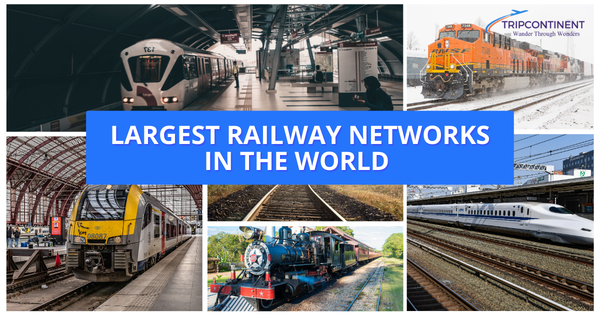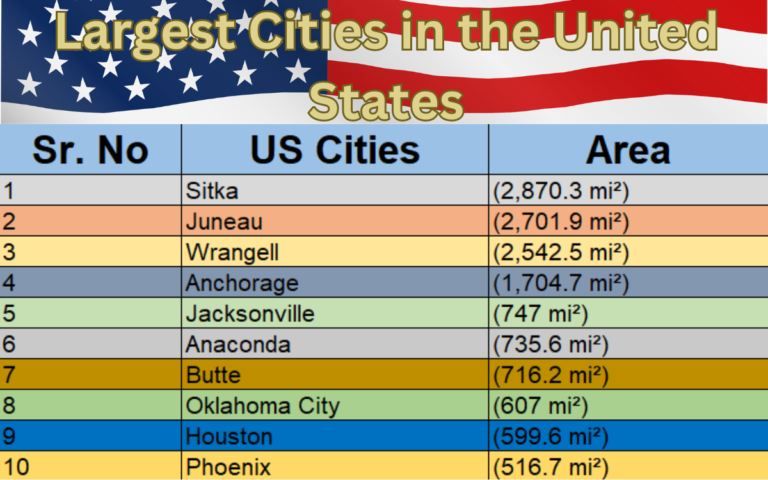Which Are the Largest Railway Networks in the World in 2024?
Railway networks are a crucial part of global transportation, connecting cities, regions, and countries by rail. Among the largest railway networks in the world, several stand out due to their extensive coverage and significant role in moving people and goods. These networks are essential for economic growth, trade, and daily commuting, highlighting the importance of rail transport in various parts of the globe.
So, let’s explore the Largest Railway Networks in the World.
List of the Largest Railway Networks in the World
The following is the list of the Largest Railway Networks in the World.
- United States: 250,000km
- China: 100,000km
- Russia: 85,500km
- India: 65,000km
- Canada: 48,000km
- Germany: 41,000km
- Australia: 40,000km
- Argentina: 36,000km
- France: 29,000km
- Brazil: 28,000km
1. United States: 250,000km
The United States boasts one of the largest and most crucial railway networks globally, spanning over 250,000 kilometers (about 155,000 miles). This extensive system is integral to the country’s transportation infrastructure, playing a significant role in moving both goods and passengers across the nation.
Historically, railroads were vital to America’s expansion westward in the 19th century. The completion of the first transcontinental railroad in 1869 marked a monumental achievement, connecting the East and West Coasts and facilitating rapid growth and development.
Today, the U.S. railway system is dominated by major freight rail companies like Union Pacific, BNSF Railway, and Norfolk Southern. These companies are responsible for handling a vast majority of freight traffic, and transporting essential goods such as coal, oil, agricultural products, and manufactured items. Rail transport is known for being more fuel-efficient and cost-effective over long distances compared to trucking.
Passenger rail service in the U.S. is primarily provided by Amtrak, which offers routes across the country. Although passenger rail travel is less common in the U.S. compared to regions like Europe or Asia, it remains an important option for many travelers.
The railway network’s infrastructure includes thousands of miles of tracks, bridges, tunnels, and rail yards. Ensuring the safety and efficiency of this infrastructure is a continuous task, with ongoing investments in modernization. These improvements include upgrading tracks, introducing high-speed rail projects, and enhancing safety technologies.
Economically, railroads are a powerhouse, supporting millions of jobs and contributing significantly to the U.S. economy. They are essential for connecting industries and markets, which helps facilitate trade and commerce. Additionally, trains offer environmental benefits, producing fewer emissions per ton-mile than trucks and planes, making them a greener transportation option.
You might also like: Seven Wonders of the World
2. China: 100,000km
China has developed one of the most impressive and extensive railway networks in the world, covering approximately 100,000 kilometers (about 62,000 miles). This vast network plays a crucial role in the country’s transportation system, facilitating the movement of both goods and passengers.
China’s railway system has grown rapidly over the past few decades. Modern development began in the late 20th century, with a major expansion starting in the 2000s. The country now boasts one of the largest high-speed rail networks globally, featuring trains that can travel at speeds of over 300 kilometers per hour (about 186 miles per hour). This high-speed rail network has significantly reduced travel times between major cities, making train travel a popular choice for many people.
The Chinese railway system is managed by China Railway Corporation, which oversees both freight and passenger services. The network includes traditional rail lines as well as a vast array of high-speed rail routes. Freight trains are essential for transporting goods like coal, steel, and consumer products across the country, while passenger trains offer a convenient and efficient means of travel for millions.
One of the key achievements of China’s railway network is the development of the “Belt and Road Initiative,” a global infrastructure project aimed at improving trade routes between China and other countries. This initiative includes expanding rail connections to neighboring countries, and facilitating international trade and economic cooperation.
China’s railway system is not just about speed and efficiency; it also focuses on modernization and safety. Investments are continually being made to upgrade tracks, introduce advanced technologies, and improve overall safety standards. The emphasis on innovation helps ensure that the network remains one of the most advanced in the world.
3. Russia: 85,500km
Russia has one of the largest railway networks in the world, stretching about 85,500 kilometers (approximately 53,000 miles). This extensive system is crucial for connecting the vast and diverse regions of the country, which spans eleven time zones.
The Russian railway network is historically significant and dates back to the 19th century. The Trans-Siberian Railway, one of the most famous and longest railways in the world, was completed in 1916. It stretches from Moscow in the west to Vladivostok on the Pacific Ocean, covering over 9,000 kilometers (about 5,600 miles). This railway is essential for transporting goods and passengers across the vast Siberian region.
The network is managed by Russian Railways, a state-owned company responsible for both passenger and freight services. Russian Railways operates a wide range of trains, including long-distance passenger trains, high-speed trains, and freight trains. The system is crucial for moving natural resources such as oil, coal, and timber, which are abundant in Russia.
In recent years, Russia has invested in modernizing its railway infrastructure. This includes upgrading tracks, improving stations, and introducing new technologies to enhance efficiency and safety. The development of high-speed rail lines is also part of the modernization efforts, aiming to reduce travel times between major cities and boost economic activity.
The Russian railway network plays a significant role in the country’s economy by facilitating trade and connecting remote areas with major industrial centers. It also supports millions of passengers each year, offering a reliable and affordable means of travel across the vast expanse of Russia.
4. India: 65,000km
India’s railway network is one of the largest in the world, stretching approximately 65,000 kilometers (about 40,000 miles). This vast system plays a critical role in connecting the country’s diverse regions and supporting its economic activities.
The Indian railway system is managed by Indian Railways, a government-run organization responsible for operating both passenger and freight services. Established in the 1850s, the railway network has grown significantly over the years, evolving into a crucial component of India’s infrastructure.
Passenger rail services are a major focus of Indian Railways. The network serves millions of people daily, offering a wide range of trains, from luxurious express trains to local commuter services. The railways are essential for providing affordable and reliable transportation across the country, especially for people traveling between cities and rural areas.
Freight transport is another critical aspect of India’s railway network. The railways are used to move a variety of goods, including coal, iron ore, cement, and agricultural products. This freight network supports industries and helps in the efficient distribution of resources across the nation.
In recent years, India has been investing heavily in modernizing its railway infrastructure. This includes upgrading tracks, improving safety measures, and introducing new technologies to enhance the speed and efficiency of trains. The development of high-speed rail corridors, such as the Mumbai-Ahmedabad route, is part of these modernization efforts, aiming to reduce travel times and boost economic growth.
Indian Railways also plays a significant role in promoting tourism. Iconic trains like the Palace on Wheels offer luxurious travel experiences, showcasing India’s rich heritage and diverse landscapes.
5. Canada: 48,000km
Canada’s railway network spans about 48,000 kilometers (approximately 30,000 miles), making it one of the largest in North America. This extensive system plays a vital role in connecting the vast and diverse regions of Canada, from the Atlantic Ocean in the east to the Pacific Ocean in the west.
The Canadian railway system is primarily managed by two major freight rail companies: Canadian National Railway (CN) and Canadian Pacific Railway (CP). These companies are responsible for transporting a wide range of goods, including natural resources like oil, coal, and grain, as well as manufactured products. Freight rail is crucial for Canada’s economy, as it efficiently moves large quantities of goods across long distances.
Passenger rail services in Canada are provided by VIA Rail, which operates several long-distance routes connecting major cities and regions. VIA Rail offers a variety of travel options, from economy class to more comfortable accommodations. Although passenger rail travel is less common in Canada compared to some other countries, it remains an important option for many travelers, especially those looking to experience scenic journeys through the Canadian landscape.
One of the most famous rail routes in Canada is the Canadian, operated by VIA Rail, which travels from Toronto to Vancouver. This route showcases the country’s stunning scenery, including the Rocky Mountains, Prairies, and forests.
Canada’s railway network also supports significant economic activity through the transportation of goods to and from the United States, its largest trading partner. The network includes key border crossings and connections that facilitate international trade.
In recent years, Canada has been investing in modernizing its railway infrastructure. These investments focus on upgrading tracks, enhancing safety measures, and incorporating new technologies to improve efficiency and service quality.
Also explore: 10 Most Educated Countries In The World
6. Germany: 41,000km
Germany’s railway network covers about 41,000 kilometers (approximately 25,500 miles), making it one of the most extensive and well-developed in Europe. This network plays a crucial role in the country’s transportation system, connecting major cities, towns, and industrial regions.
The German railway system is operated by Deutsche Bahn (DB), the state-owned company responsible for both passenger and freight services. DB operates a comprehensive range of services, including high-speed trains, regional trains, and local commuter trains. The network is known for its efficiency, punctuality, and extensive coverage.
One of the standout features of Germany’s railway network is its high-speed rail system. The Intercity-Express (ICE) trains are capable of reaching speeds up to 300 kilometers per hour (about 186 miles per hour), making travel between major cities like Berlin, Munich, and Frankfurt both fast and convenient. These high-speed trains are a popular choice for business travelers and tourists alike.
In addition to high-speed trains, Germany’s railway system includes extensive regional and local services. Regional trains connect smaller towns and cities, while local commuter trains, such as the S-Bahn, serve metropolitan areas and suburbs. This connectivity ensures that passengers have access to reliable transportation throughout the country.
Freight transportation is also a significant part of Germany’s railway network. The rail system is used to move a wide range of goods, including industrial products, raw materials, and consumer goods. Efficient freight transport supports Germany’s strong industrial base and export-oriented economy.
Germany has been investing in modernizing its railway infrastructure, focusing on upgrading tracks, expanding networks, and incorporating new technologies. These investments aim to improve service quality, increase capacity, and enhance overall efficiency.
7. Australia: 40,000km
Australia’s railway network spans approximately 40,000 kilometers (about 25,000 miles), playing a crucial role in connecting the country’s vast and diverse regions. This extensive network is essential for both freight and passenger transport across the continent.
The Australian railway system is managed by several state and national operators, with each state handling its rail services. Major rail operators include Aurizon, which focuses on freight transport, and the Australian Rail Track Corporation (ARTC), which manages some of the main freight corridors. Passenger services are operated by various state-owned companies, such as NSW TrainLink in New South Wales and V/Line in Victoria.
Australia’s railway network is known for its long-haul freight routes, which are vital for transporting bulk goods like coal, iron ore, and agricultural products from remote regions to ports for export. The network includes significant rail lines such as the Trans-Australian Railway, which connects the east and west coasts, and the Ghan, which runs from Adelaide to Darwin through the heart of the continent.
Passenger rail services in Australia include both intercity and regional trains. Major cities like Sydney, Melbourne, Brisbane, and Perth are connected by well-developed rail services that offer a range of travel options from local commuter trains to long-distance journeys. The Indian Pacific, another notable long-haul train, runs from Sydney to Perth, showcasing Australia’s diverse landscapes.
In recent years, Australia has been investing in modernizing and expanding its railway infrastructure. Projects such as new high-speed rail proposals and network expansions aim to improve connectivity, reduce travel times, and support economic growth.
8. Argentina: 36,000km
Argentina’s railway network extends approximately 36,000 kilometers (about 22,000 miles), making it one of the largest in South America. This extensive system plays a crucial role in the country’s transportation infrastructure, linking major cities, rural areas, and key economic regions.
The Argentine railway system is managed by several national and regional operators. The state-owned company, Trenes Argentinos, oversees most of the passenger services, while freight operations are handled by various private and public companies. The network includes both passenger and freight trains, serving a diverse range of needs.
One of the significant features of Argentina’s railway network is its role in transporting goods. The railway system is essential for moving agricultural products, such as soybeans and wheat, from the rural areas where they are produced to ports for export. This is crucial for Argentina’s economy, as agriculture is a major sector, and export revenue is significant.
Passenger rail services in Argentina include both long-distance and suburban trains. Major routes connect Buenos Aires, the capital city, with other key cities like Córdoba, Rosario, and Mendoza. Suburban trains serve the metropolitan areas, providing essential transportation for daily commuters. The network is known for its historic trains, with some routes dating back to the early 20th century.
In recent years, Argentina has been working on modernizing and expanding its railway infrastructure. Investments are being made to upgrade tracks, improve safety, and introduce new technologies. Projects like the high-speed rail link between Buenos Aires and Rosario aim to enhance travel efficiency and connectivity.
9. France: 29,000km
France’s railway network covers about 29,000 kilometers (approximately 18,000 miles), making it one of the most extensive in Europe. This well-developed system is crucial for connecting the country’s cities, towns, and regions, and plays a key role in its transportation infrastructure.
The French railway system is managed by SNCF (Société Nationale des Chemins de fer Français), the state-owned company responsible for both passenger and freight services. SNCF operates a wide range of trains, including high-speed trains, regional trains, and local commuter services.
One of the standout features of France’s railway network is its high-speed rail system. The TGV (Train à Grande Vitesse) trains are capable of reaching speeds up to 320 kilometers per hour (about 200 miles per hour), making travel between major cities like Paris, Lyon, Marseille, and Bordeaux both fast and convenient. The TGV network is known for its punctuality and efficiency, and it has set benchmarks for high-speed rail around the world.
In addition to high-speed services, France has an extensive network of regional and local trains. The TER (Transport Express Régional) trains connect smaller towns and cities within regions, while the RER (Réseau Express Régional) provides rapid transit within the Paris metropolitan area. This connectivity ensures that passengers have access to reliable transportation throughout the country.
Freight transport is also an important part of France’s railway network. The system is used to move a variety of goods, including industrial products, raw materials, and consumer goods. Efficient freight transport supports the country’s economy and helps in the distribution of resources.
France has been investing in modernizing its railway infrastructure, focusing on upgrading tracks, expanding networks, and incorporating new technologies. These investments aim to improve service quality, increase capacity, and enhance overall efficiency.
10. Brazil: 28,000km
Brazil’s railway network spans approximately 28,000 kilometers (about 17,400 miles), making it a key component of the country’s transportation infrastructure. This extensive system is crucial for connecting various regions, especially given Brazil’s vast size and diverse geography.
The Brazilian railway system is managed by a mix of state and private operators. The federal government, through the National Department of Transport Infrastructure (DNIT) and the Ministry of Infrastructure, oversees the network, while various private companies handle operations and maintenance.
One of the main functions of Brazil’s railway network is freight transport. The system is essential for moving goods such as soybeans, iron ore, and other agricultural and mineral products from the interior regions to ports for export. The railway network plays a critical role in supporting Brazil’s economy, particularly its export-oriented sectors.
Passenger rail services in Brazil are less developed compared to other transportation modes, such as buses and planes. However, there are key regional and suburban rail lines that serve major cities and their surrounding areas. For instance, the suburban trains in São Paulo and Rio de Janeiro are crucial for daily commuting. There are also some long-distance trains, such as the Carajás Railway, which connects the Carajás mine in the Amazon region to the port of São Luís.
In recent years, Brazil has been focusing on modernizing and expanding its railway infrastructure. Projects include upgrading existing tracks, introducing new technologies, and expanding the network to improve connectivity and efficiency. There are also efforts to develop high-speed rail and enhance passenger services to better meet the needs of travelers.
Also read: Most Rich States in the USA
Conclusion
The largest Railway Networks in the World are not just about length but also about the range of services they offer, including high-speed trains, regional connections, and freight transport. They enable the movement of goods and people across long distances, which is crucial for both national and international trade.
As these countries continue to invest in their railway infrastructure, the networks are expected to become even more efficient and integrated, further enhancing their ability to connect people and support economic activities.
FAQs
Which Is the Largest Rail Network in Asia?
The largest railway network in Asia is in China. With approximately 100,000 kilometers (about 62,000 miles) of railways, China’s network is the largest in the continent and includes one of the most extensive high-speed rail systems in the world.
Which Is the Biggest Railway Platform in the World?
The biggest railway platforms in the world, based on platform area and passenger capacity, are:
- Gorakhpur Junction (India): Gorakhpur Junction, located in Uttar Pradesh, India, is known for having the longest railway platform in the world. It stretches over 1,366 meters (4,482 feet), accommodating a large number of trains and passengers.
- Grand Central Terminal (New York City, USA): While not the longest, Grand Central Terminal is one of the largest railway stations in the world by platform area and passenger volume. It features 44 platforms and 67 tracks, serving hundreds of thousands of passengers daily.
Which Country Has No Railway Track?
Several countries do not have railway tracks, often due to their small size, geographic characteristics, or lack of infrastructure development. One notable example is Vatican City, the world’s smallest independent state. Another example is Monaco, a small city-state on the French Riviera.
Which Is the Busiest Railway Station in the World?
The Shinjuku Station in Tokyo, Japan, holds the title of the busiest railway station in the world. Shinjuku Station handles an extraordinary number of passengers daily, with estimates often exceeding 3.5 million passengers per day. This station serves as a major transportation hub, integrating multiple train lines, including the JR East lines, Tokyo Metro, and private railways.
What Is the Most Famous Railway Station in the World?
One of the most famous railway stations in the world is Grand Central Terminal in New York City, USA. Grand Central Terminal is renowned for its stunning architecture, historic significance, and central role in New York City’s transportation network.
Grand Central Terminal is not only a major transportation hub but also a significant cultural landmark, appearing in numerous films, television shows, and works of literature.

I’m Sophia Jones, an adventurer at heart from New York City, USA. I live for travel and exploration, always eager to discover new places, meet fascinating people, and try out diverse cuisines. Over the past few years, I’ve traveled to numerous countries, immersing myself in different cultures and creating unforgettable memories.






